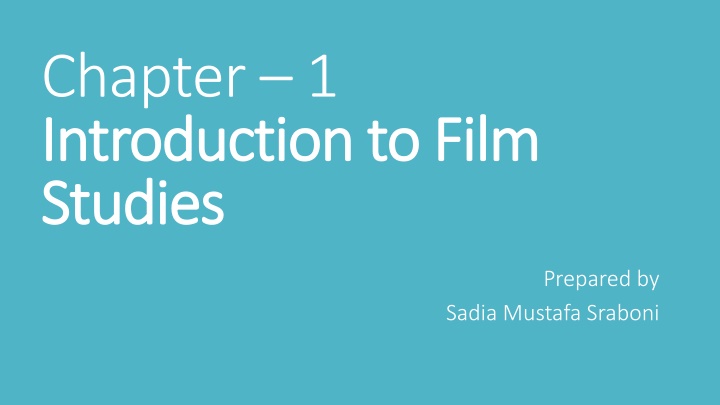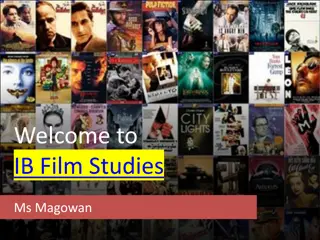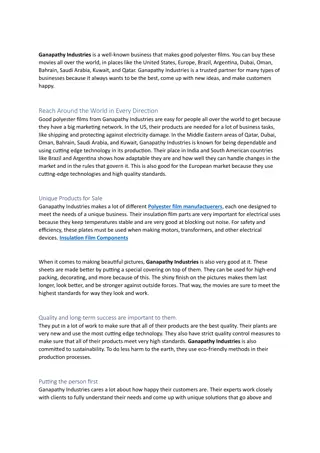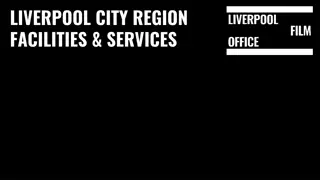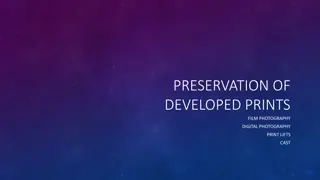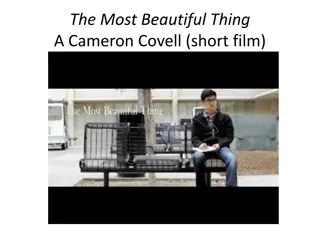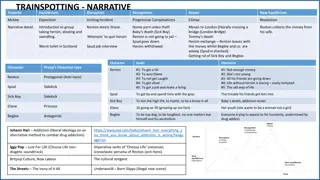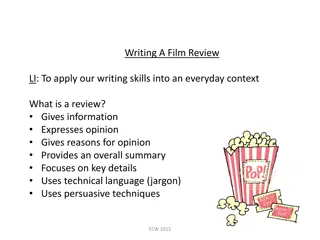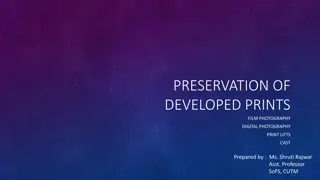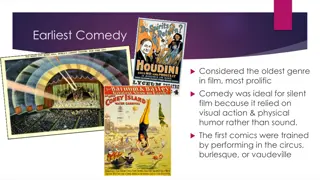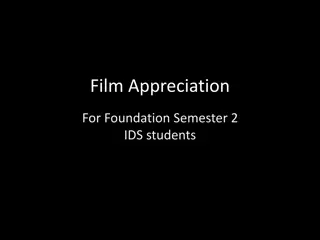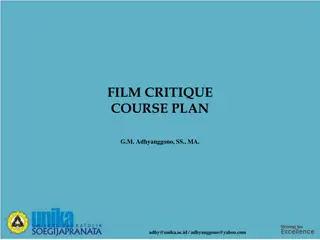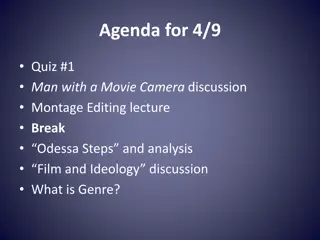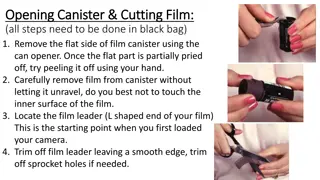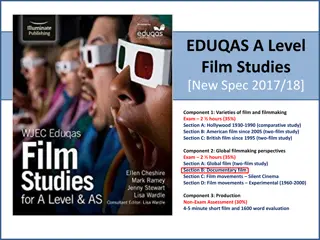Chapter – 1 Introduction to Film Studies
Film studies is an academic discipline that focuses on the theoretical, historical, and critical aspects of cinema as an art form. It delves into the analysis of film content, form, narrative, technique, and cultural context. This article provides an introduction to film studies, highlighting its history, major concepts, modern developments, common curriculum, and career opportunities in the field.
Download Presentation

Please find below an Image/Link to download the presentation.
The content on the website is provided AS IS for your information and personal use only. It may not be sold, licensed, or shared on other websites without obtaining consent from the author.If you encounter any issues during the download, it is possible that the publisher has removed the file from their server.
You are allowed to download the files provided on this website for personal or commercial use, subject to the condition that they are used lawfully. All files are the property of their respective owners.
The content on the website is provided AS IS for your information and personal use only. It may not be sold, licensed, or shared on other websites without obtaining consent from the author.
E N D
Presentation Transcript
Chapter 1 Introduction to Film Introduction to Film Studies Studies Prepared by Sadia Mustafa Sraboni
What is Film studies? Film studies is an academic discipline that deals with various theoretical, historical, and critical approaches to cinema as an art form and a medium. It is sometimes subsumed within media studies and is often compared to television studies. Film studies is an institutionalized academic discipline that focuses on the serious study of films, cinematic history and film culture and is majorly informed by film theory. Unlike what some people may believe, film studies is not concerned with filmmaking or the technicalities of film production itself but is rather focused on studying cinema the way one would with art or literature. It involves not just analyzing the content of a film, but also looking into its form, the narrative, technique, stylistic elements and the historical, socio-political, economic, and cultural aspects and context surrounding it. This article aims to provide an introduction to what the field entails by delving into its history and further looking into some of the major concepts involved.
Modern film studies Today film studies exists worldwide as a discipline with specific schools dedicated to it. The aspects of film studies have grown to encompass numerous methods for teaching history, culture and society. Although each institution has the power to form the study material, students are usually expected to grasp a knowledge of conceptual shifts in film, a vocabulary for the analysis of film form and style, a sense of ideological dimensions of film, and an awareness of extra textual domains and possible direction of film in the future. Universities offer their students a course in the field of film analysis to critically engage with the production of films which also allows the students to take part in research and seminars of specialized topics to enhance their critical abilities.
Common curriculum 1. Introduction to film studies 2. Modes of film studies 3. Close analysis of film 4. History of film/media 5. Analysis with emphasis -Attention to time period -Attention to regional creation -Attention to genre -Attention to creators 6. Methods of film production
Career opportunities Broadcast presenter Film director Film/video editor Production designer, theatre/television/film Programme researcher, broadcasting/film/video Television camera operator Television/film/video producer Television production coordinator
Career opportunities Jobs where your degree would be useful include: Marketing executive Public relations officer Advertising art director Special effects technician Arts administrator Talent agent Community arts worker VFX artist Concept artist Event manager
What is Film? A film, also called a movie, motion picture or moving picture, is a work of visual art used to simulate experiences that communicate ideas, stories, perceptions, feelings, beauty, or atmosphere through the use of moving images. These images are generally accompanied by sound, and more rarely, other sensory stimulations. The word "cinema", short for cinematography, is often used to refer to filmmaking and the film industry, and to the art form that is the result of it. The moving images of a film are created by photographing actual scenes with a motion-picture camera, by photographing drawings or miniature models using traditional animation techniques, by means of CGI and computer animation, or by a combination of some or all of these techniques, and other visual effects.
Key words about Film Key words about Film
Mise Mise- -en en- -sc ne sc ne From the French, it was originally a stage (not screen) term that meant that which has been put into the scene or put onstage. In cinema, mise-en-scene consists of all of the elements placed in front of the camera to be photographed: figure behavior meaning actors their gestures and their facial expressions and the camera s actions and angles and the cinematography. Settings props lighting costumes makeup
Basic Terms Basic Terms Shot Shot: : A shot is the basic element of filmmaking a piece of film run through the camera, exposed, and developed; an uninterrupted run of the camera; or an uninterrupted image on film. Scene Scene: : While a shot is a unit of length or duration a minimal unit of dramatic material, a scene is a longer unit, usually of several shots or more. Take Take: : a single recording of a shot. If the director doesn t like something that occurs in Take 1, she may run the shot again by calling out Take 2 until she is ready to call print!
Cut: Cut: A cut is the basic element of film editing an abrupt film transition from one sequence to another. The cut, dissolve and wipe serve as the three primary transitions. Dissolve: Dissolve: moving gradually from one picture to another. Sometimes refers to a series of such transitions. Wipe: Wipe: one shot replaces another by traveling from one side of the frame to another or with a special shape. Fade: Fade: The terms fade-out and fade-in are used to describe a transition to and from a blank image.
Camera Distance Camera Distance One way directors have of providing expression to each shot they film is to vary the distance between the camera and the subject being filmed. In general, the closer the camera is to the subject, the more emotional weight the subject gains: A CLOSE-UP is a shot that isolates an object in the image, making it appear relatively large. An EXTREME CLOSE-UP might be of the person s eyes or mouth or nose or any element isolated at very close range in the image. A MEDIUM SHOT appears to be taken from a medium distance; in terms of the human body, it s from the waist up.
A THREEQUARTER SHOT takes in the human body from just below the knees. A FULL SHOT is of the entire human body. A LONG SHOT appears to be taken from a long distance. Remember: lenses are able to create the illusion of distance or closeness. There are also EXTREME LONG SHOTS, which show the object or person at a vast distance surrounded by a great amount of the surrounding space.
Camera Angles Camera Angles In addition to subject-camera distance, directors employ different camera angles to provide expressive content to the subjects they film. When directors simply want to film a person or room or landscape from an angle that seems unobtrusive and normal (whatever the word normal actually means), they place the camera at the level of an adult s eyes, which is to say five or six feet off the ground when the characters are standing, lower when they are seated. This, not surprisingly, is called an EYE LEVEL SHOT. When the director shoots his or her subjects from below, the result is a LOW-ANGLE SHOT; with a low-angle shot, the camera is in effect looking up at the subject. Typically, directors use low-angle shots to aggrandize their subjects. After all, to look up to someone means that you admire that person.
And when he or she shoots the subject from above, the result is a HIGH-ANGLE SHOT; the camera is looking down. High-angle shots, because they look down on the subject, are often used to subtly criticize the subject by making him or her seem slightly diminished, or to distance an audience emotionally from the character. An extreme overhead shot, taken seemingly from the sky or ceiling and looking straight down on the subject, is known as a BIRD S-EYE VIEW. The terms close-up, low-angle shot, extreme long shot, and others assume that the camera is facing the subject squarely, and for the most part shots in feature films are indeed taken straight-on. But a camera can tilt laterally on its axis, too. When the camera tilts horizontally and/or vertically it s called a DUTCH TILT or a canted angle.
When a director sets up a TWO-SHOT, he or she creates a shot in which two people appear, generally in medium distance or closer, though of course there can be two- shots of a couple or other type of pair walking that would reveal more of their lower bodies. The point is that two-shots are dominated spatially by two people, making them ideal for conversations. REVERSE-SHOT PATTERN: an editing technique that records the interaction between two characters, usually a conversation, who are facing one another with one series of shots often taken over the shoulder of one character and another series of shots taken over the shoulder of the other character; note that the so-called reverse shot is not actually taken from the truly opposite angle, because such an angle would violate the 180 system.
A THREE-SHOT, of course, contains three peoplenot three people surrounded by a crowd, but three people who are framed in such a way as to constitute a distinct group. Finally, a MASTER SHOT is a shot taken from a long distance that includes as much of the set or location as possible as well all the characters in the scene. For example, a scene set in a dining room could be filmed in master shot if the camera was placed so that it captured.
Perspective Perspective One One- -point perspective: point perspective: One vanishing point is typically used for roads, railway tracks, hallways, or buildings viewed so that the front is directly facing the viewer. from above (or below). Two Two- -point perspective: point perspective: Two-point perspective can be used to draw the same objects as one-point perspective, rotated: looking at the corner of a house, or looking at two forked roads shrink into the distance, for example Three Three- -point perspective: point perspective: Three-point perspective is usually used for buildings seen from above (or below). In addition to the two vanishing points from before, one for each wall, there is now one for how those walls recede into the ground or into the sky.
